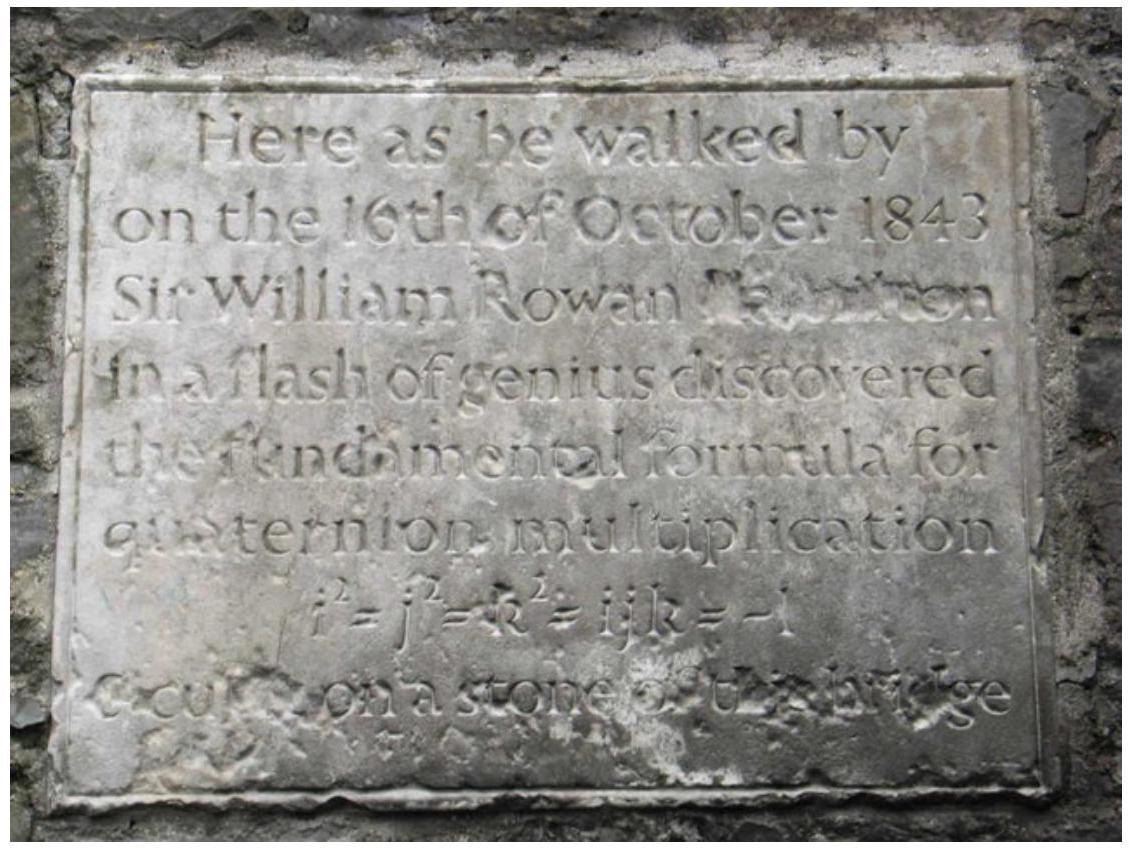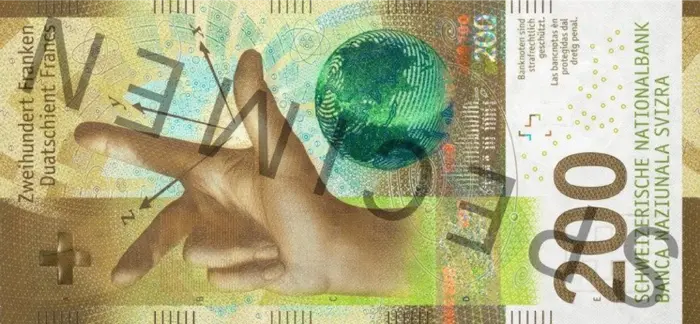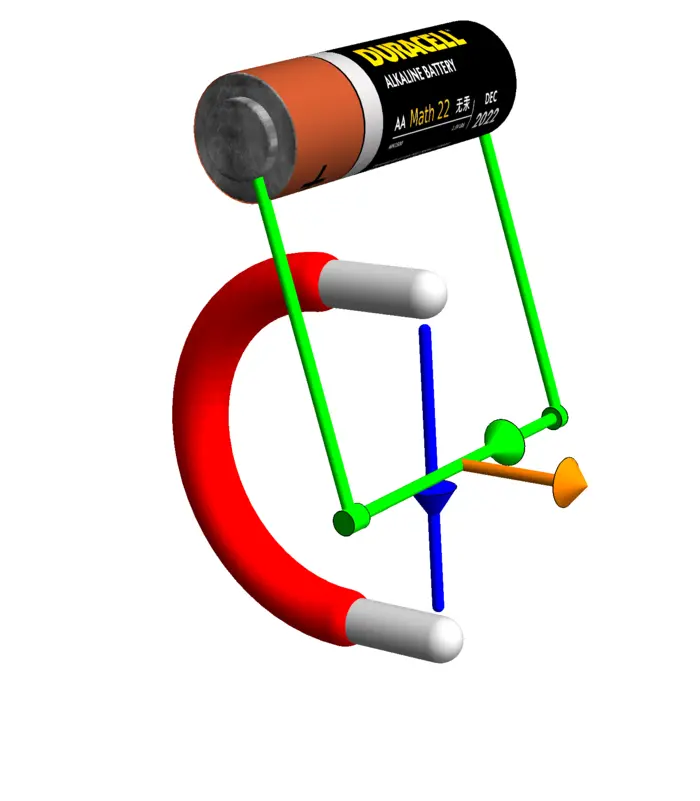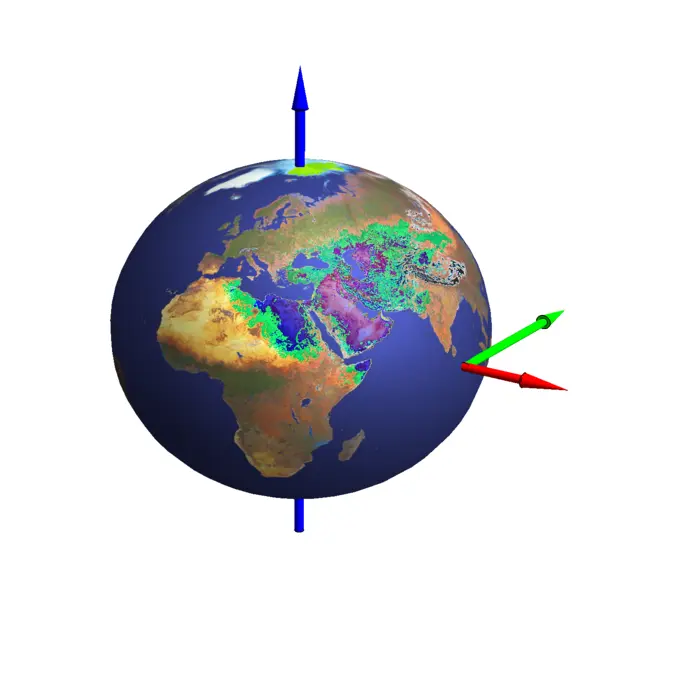Cross Product
Table of Contents
4.1 INTRODUCTION

4.1.1 Vector Multiplication Evolution
We have seen that we can multiply square matrices and get again a matrix. Wouldn’t it be nice if we could also multiply two vectors and get a vector back. The dot product, which is the matrix product of a row vector with a column vector gave us a number. The matrix product of a column vector with a row vector would give us a square matrix. How can we design a product of column vectors which again gives us a column vector? This was the question which William Rowan Hamilton pondered for many years. The story goes that every morning, when he would come down to the breakfast table, his young son would ask "Dad, can you already multiply triplets?" to which William answered: "No Son, I do not know how to do that yet".
4.1.2 Quaternions and Cross Product
Eventually, Hamilton succeeded. The legend goes that while walking with his wife along the Royal Canal in Dublin, while crossing the Brougham bridge, he suddenly got the inspiration: one has to multiply quadruplets! These numbers would be written as \(a+b i+c j+d k\) where \(i, j, k\) are symbols satisfying \(i^{2}=j^{2}=k^{2}=i j k=-1\). He was so happy that he would would devote the rest of his life with these numbers. Now it turns out that this algebra also produces a product of vectors which is called the cross product. It has a lot of nice properties like that the product of two vectors is perpendicular and that the length is related to area. It also has amazing applications in physics.
4.2 LECTURE
4.2.1 Uniqueness of \(\mathbb{R}^{3}\)
The three dimensional space \(\mathbb{R}^{3}\) is special. It is not only the only Euclidean space in which the Kepler problem is stable1, it also features a cross product \(v \times w\) which is in the same space. Such a product can be defined in \(\mathbb{R}^{n}\) but it produces a vector in \(\mathbb{R}^{n(n-1) / 2}\). It happens that for \(n=3\) that the result is again in \(\mathbb{R}^{3}\). The problem of "multiplying triplets" has been pondered by William Hamilton in the first half of the 19th century and is related to the fascinating story of quaternions. The discovery of quaternions was simultaneously the birth place of the dot and cross product.
4.2.2 Cross Product Properties
The cross product of two vectors \(v=\left[v_{1}, v_{2}, v_{3}\right]^{T}\) and \(w=\left[w_{1}, w_{2}, w_{3}\right]^{T}\) is
\[\left[\begin{array}{l} v_{1} \\ v_{2} \\ v_{3} \end{array}\right] \times\left[\begin{array}{l} w_{1} \\ w_{2} \\ w_{3} \end{array}\right]=\left[\begin{array}{l} v_{2} w_{3}-v_{3} w_{2} \\ v_{3} w_{1}-v_{1} w_{3} \\ v_{1} w_{2}-v_{2} w_{1} \end{array}\right]\]
Take the dot product with \(v\) or \(w\) to see that \(v \times w\) is perpendicular to both \(v\) and \(w\). Obvious is also \(v \times w=-w \times v\). The product is handy for constructions in \(\mathbb{R}^{3}\). The vectors \(v, w, v \times w\) are oriented like the first three fingers on the right hand: if \(v\) is the thumb, \(w\) is the pointing finger, then \(v \times w\) is the middle finger. Let \(v \cdot w=|v||w| \cos (\alpha)\):
Theorem 1. \(|v \times w|=|v||w| \sin (\alpha)\) and \(v \cdot(v \times w)=w \cdot(v \times w)=0\).
Proof. We will verify in class by brute force the Lagrange’s identity \[|v \times w|^{2}= |v|^{2}|w|^{2}-(v \cdot w)^{2}\] which is also called Cauchy-Binet formula. Now use \(|v \cdot w|=|v||w| \cos (\alpha)\) to get the result with \(\cos ^{2}(\alpha)+\sin ^{2}(\alpha)=1\). ◻
4.2.3 Geometric Sine Applications
Given a triangle with side lengths \(a, b, c\) and angles \(\alpha, \beta, \gamma\), where \(\alpha\) is opposite to \(a\) etc. We have the following \(\boldsymbol{\sin}\)-formula
Corollary 1. \(\frac{a}{\sin (\alpha)}=\frac{b}{\sin (\beta)}=\frac{c}{\sin (\gamma)}.\)
Proof. We can use the theorem and express the area of the triangle as \(a b \sin (\gamma)\) or \(b c \sin (\alpha)\) or \(a c \sin (\beta)\). By equating these three quantities and dividing out the common factor, we get the \(\sin\)-formula. ◻
4.2.4 Geometric Area Insights
This is useful in applications as to define the area of the parallelogram as \(|v \times w|\). That this is justified can be seen in two dimensions and:
Corollary 2. \(|v \times w|\) is the parallelogram area spanned by \(v\) and \(w\).
Proof. Use the formula \(|v \times w|=|v||w| \sin (\alpha)\) and note that \(|w| \sin (\alpha)\) is the height of the parallelogram spanned by \(v\) and \(w\). The base length is \(|v|\). ◻
4.2.5 Triple Scalar Product
The scalar \(u \cdot(v \times w)\) is called the triple scalar product of \(u, v, w\). Its sign defines an orientation of the three vectors. It is also the determinant of the matrix \[\left[\begin{array}{lll} u_{1} & v_{1} & w_{1} \\ u_{2} & v_{2} & w_{2} \\ u_{3} & v_{3} & w_{3} \end{array}\right].\] The absolute value of \(u \cdot v \times w\) defines the volume of the parallelepiped spanned by \(u\), \(v\) and \(w\). Without the absolute value, we also speak of signed volume.
4.2.6 Side Remark: Cross Product in Higher Dimensions
In higher dimensions, the cross product is called exterior product. One uses \(\wedge\) rather than \(\times\) which is used in three dimensions. If \(I=(i, j)\) is a choice of two elements in \(\{1,2, \ldots, n\}\) and \(v, w\) are two vectors in \(\mathbb{R}^{n}\), then \((v \wedge w)_{I}=\) \(v_{i} w_{j}-v_{j} w_{i}\). The formula \(|v \wedge w|=|v||w| \sin (\alpha)\) still holds and the proof is the same. We only need again to verify the Cauchy-Binet formula \(|v|^{2}|w|^{2}-(v \cdot w)^{2}=|v \wedge w|^{2}\). But this is better done using matrices. If \(A\) is the matrix which contains \(v, w\) as columns, then \(\operatorname{det}(A^{T} A)=\sum_{P} \operatorname{det}(A_{P})^{2}\), where the sum on the right is over all \(2 \times 2\) submatrices \(A_{P}\) of \(A\). The expression \(\operatorname{det}(A_{P})\) is called a minor. Cauchy-Binet formula is super cool2. By the way, if we have \(k\) vectors and build \(A \in M(n, k)\), a matrix which has these vectors as columns. Now, \(\operatorname{det}(A^{T} A)\) is the volume of the parallelepiped spanned by these vectors. And Cauchy-Binet writes this as a sum of squares of \(k\)-dimensional volumes of projections which is in some sense a generalization of Pythagoras.
4.3 EXAMPLES
Example 1. What is the area of the triangle \(A=(1,1,1)\), \(B=(3,5,2)\) and \(C=(2,0,3)\)? We find the cross product between the vector \([2,4,1]^{T}\) going from \(A\) to \(B\) and the vector \([1,-1,2]^{T}\) going from \(A\) to \(C\). The cross product is \[\left[\begin{array}{l} 2 \\ 4 \\ 1 \end{array}\right] \times\left[\begin{array}{c} 1 \\ -1 \\ 2 \end{array}\right]=\left[\begin{array}{c} 9 \\ -3 \\ -6 \end{array}\right]\] Its length is \(3 \sqrt{14}\). The area of the triangle is half of it: \(3 \sqrt{14} / 2\).
Example 2. Find the volume of the parallelepiped with vertices \(O=(0,0,0)\) and attached corners \(A=(1,1,1)\), \(B=(3,4,2)\) and \(C=(2,0,3)\). The signed volume is \[\left[\begin{array}{l} 1 \\ 1 \\ 1 \end{array}\right] \cdot\left(\left[\begin{array}{l} 3 \\ 4 \\ 2 \end{array}\right] \times\left[\begin{array}{l} 2 \\ 0 \\ 3 \end{array}\right]\right)=\left[\begin{array}{l} 1 \\ 1 \\ 1 \end{array}\right] \cdot\left[\begin{array}{c} 12 \\ -5 \\ -8 \end{array}\right]=-1 .\] and take the absolute value. A negative number indicates that \(OA\), \(OB\), \(OC\) is left handed.
4.4 ILLUSTRATIONS



EXERCISES
Exercise 1. Find a vector \(w\) perpendicular to the vectors \(u=[2,3,4]^{T}\) and \(v=[3,4,7]^{T}\). Then use this result to find a vector \(x\) perpendicular to both \(v\) and \(w\).
Exercise 2. A 3D scanner is used to build a 3D model of a face. It detects a triangle which has its vertices at \(P=(2,1,1)\), \(Q=(1,1,0)\) and \(R=(1,2,3)\). Find the area of that triangle as well as a vector perpendicular to the triangle.3
Exercise 3. Find the volume of the parallelepiped which has the vertices \(O=(0,0,0)\), \(P=(2,3,1)\), \(Q=(4,3,1)\), \(R=(6,6,2)\), \(A=(1,1,1)\), \(B=(3,4,2)\), \(C=(5,4,2)\), \(D=(7,7,3)\).
Exercise 4. Investigate which of the following formulas are always true for all vectors \(u, v, w, x, y\). If it is true, either explain, cite a source (i.e. on the web), or a by hand or computer algebra verification. If it is not true, find a counter example.
- \(u \cdot(v \times w)=v \cdot(w \times u)\)
- \(u \times(v \times w)=(u \times v) \times w\)
- \(u \times(v+w)=u \times v+u \times w\)
- \(u \times(v \times w)=(u \cdot w) v-(u \cdot v) w\)
- \((u \times v) \cdot(x \times y)=(u \cdot x)(v \cdot y)-(u \cdot y)(v \cdot x)\)
Exercise 5. Given two vectors \(p=[a, b, c]^{T}\) and \(q=[u, v, w]^{T}\), build the matrices \[\begin{aligned} P= \begin{bmatrix} 0 & a & b \\ -a & 0 & c \\ -b & -c & 0 \end{bmatrix}, \quad Q= \begin{bmatrix} 0 & u & v \\ -u & 0 & w \\ -v & -w & 0 \end{bmatrix}. \end{aligned}\] Compare \(p \times q\) and \(QP - PQ\). Describe what you see. Try to formulate this as a theorem.
- by a theorem of Joseph Bertrand of 1873 and work of Sundman-von Zeipel↩︎
- O. Knill, Cauchy Binet for pseudo-determinants, Lin. Alg. and its Applications 459 (2014) 522-547↩︎
- The STL format which is used for 3D printing, has an extremely simple form. It consists of entries like
facet normal 0.15-0.97-0.20
outer loop
vertex -1.6996-0.5597-2.8360
vertex -1.8259-0.5793-2.8374
vertex -1.7232-0.5399-2.9509
endloop
endfacet
The first line gives the normal vector, then there is a loop with three vertices giving the triangle. There is obviously some redundancy as one could get the normal vector from the points using the cross product. But there is purpose: the redundant information makes working with the data structure faster, second, one can also look at situations, where the normal vector is not perpendicular to the surface, one can change the way how the is "shaded", like how light is reflected at the surface. Third, redundancy is always good to catch errors. Our genetic information in the DNA is stored in a highly redundant way. This allows error correction.↩︎